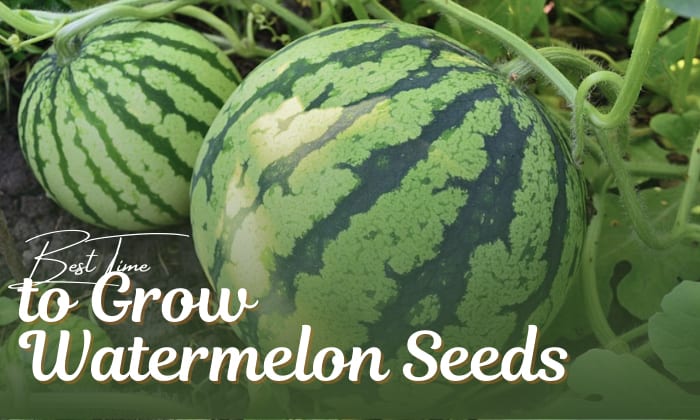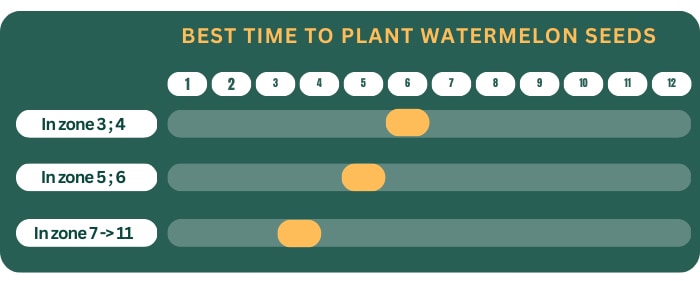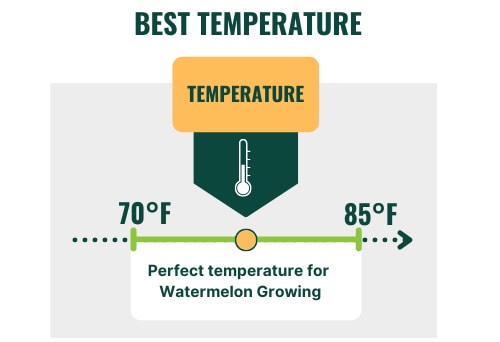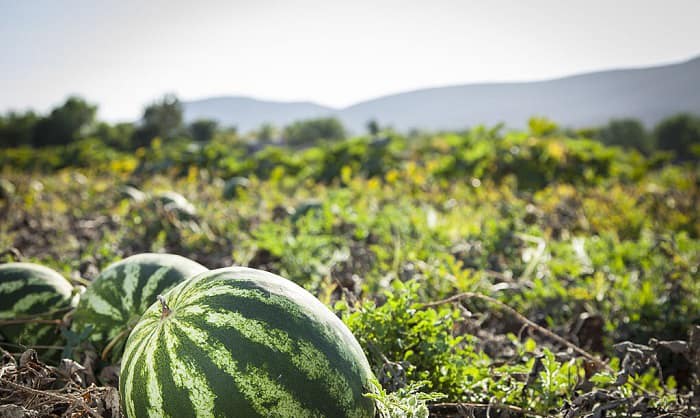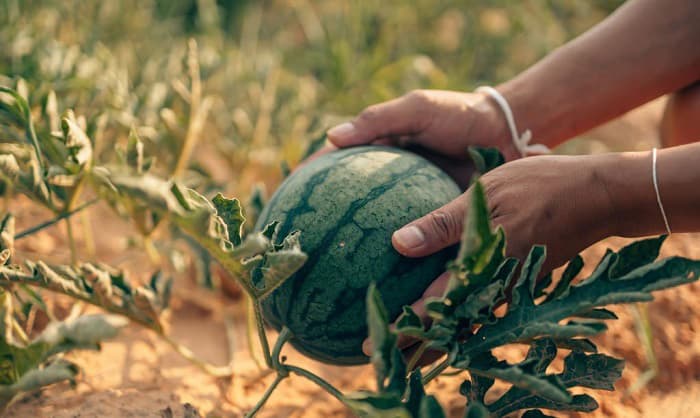Refreshing watermelons are a staple of summer. Whether incorporated into smoothies, popsicles, or eaten fresh, these fruits and their high water content will help you fight the sweltering heat of the sun.
And knowing when is the best time to plant watermelon seeds will help you go a step further in enjoying this summer snack. Usually, March to June is the planting season for watermelons, though warm locations with little frost, like Florida, can have a second gardening period in August and September.
Table of Contents
Best Time to Grow Watermelon Seeds
1. Seasons and months for planting
There are two planting times for watermelons: in the spring and in the fall.
- If you choose spring, there are two ways you can go about growing watermelon. One of them is starting seeds indoors.
For this method, plant seeds in pots three weeks before transplanting them outside.
Given that we put watermelons outdoors two weeks after the final frost, you can grow them inside your home one week before snow and ice disappear.
In zone 3 and 4, outdoor planting should happen around June, while zone 5 and 6 will do best with a May planting. As for zones 7 to 8 and 9 to 11, mid-April and mid-March are the ideal months, respectively.
- But if you opt for fall gardening instead, let watermelon plants mature and harvest them before the weather turns freezing cold. Failure to follow this recommendation means your fruits will become mushy and die along with the vines, making your work all for naught.
To put it another way, you can plant watermelon in July up until early September at the latest. After this point, the fruit will not develop any further and will need to be relegated to the trash or compost pile.
In any case, the best way to grow watermelon is to give them a temperature of 70 to 80℉. Even at night, when the air is naturally cooler, aim for 50 degrees as the minimum.
2. Planting time in different states
In the meantime, here’s a short guide on when to plant watermelon seeds by state.
| Location | What month to grow watermelons |
| In Texas | April to July |
| In Ohio | June |
| In Florida | March to April and July to August in northern areas. January to March and August to September for other locations. |
| In Georgia | Late February to early April |
| In California | April to June |
How to Plant Watermelon Seeds
Grow watermelon from seed when soil temperatures reach 70 to 80 degrees Fahrenheit. If you want some flexibility, up to 95 or down to 65 degrees should still be acceptable and conducive to crop growth.
To start, create mounds that are eight to ten inches tall and put three seeds in each mound at a depth of ¾ to 1 inch. The mounds should be 10 to 12 inches wide and three feet apart, with rows having a distance of six feet to allow vines to spread.
If possible, conduct a soil test prior to seeding and follow its fertilizer recommendation. The pH should measure 6 to 6.8, and a 5-10-10 formula mixed down to a depth of six inches to a ratio of 3 pounds/100 feet at planting time usually suffices.
You should also cover the area around the mounds with three to four inches of mulch. This step eliminates the trouble of picking up weeds with your trowel, which can inadvertently damage the fruits or the vines. It also keeps the soil warm and helps it retain moisture.
Once you’re done sowing, water the soil. Use a hose or sprinkler, and avoid using excess pressure that washes the seeds away.
People who begin their growing season for watermelon indoors should use biodegradable containers to mitigate transplant shock.
Gardeners who keep watermelons in pots long-term should pick 5-gallon or larger containers. Using a soilless mix is also ideal, as is sowing the seeds at a depth three times bigger than their lengths.
Care and Maintenance
Give watermelons one to two inches of water per week and full sun throughout their entire development.
Once the seedling has two sets of true leaves, which look lobed and similar to oak leaves, you can remove two seedlings from each mound and leave only the healthiest one in place.
Just as importantly, fertilize the watermelon throughout its growing stages: one time when the foliage first appears with a balanced or liquid seaweed fertilizer, and another two times when the vines begin to spread and fruits start forming.
Use a nitrogen-only formula, such as a 33-0-0, for vines, and give fruits a helping of compost tea to help them grow.
As the watermelon develops, prune its vines if you see rotten fruits or diseased leaves and shoots. Do the trimming under warm weather when the plant is not wet, and ensure there are male and female flowers in place to facilitate pollination.
Harvest and Storage
If you look at a planting guide, it will tell you to harvest watermelons by twisting the fruit gently until it detaches from the shoots. You may also collect the fruits by making a trim at the vine, but ensure there are two stem inches connected to the watermelons if you opt for this method.
After harvesting, the fruits will last for two to three weeks at room temperature. If you cut the rind into small pieces, store them under 9 to 36 degrees Fahrenheit and eat them within three days to a week for the best taste.
It’s also ideal to use airtight containers or plastic wrap to insulate the watermelon from other items in the fridge. In case you cannot eat the fruit quickly, putting it in the freezer will extend the storage time for up to six months.
Frequently Asked Questions
How long does it take for watermelon to grow?
Watermelons’ growth time ranges from 75 to 95 days, depending on the cultivar. For example, the Sugar Baby variety takes 75 days to reach maturity, while Black Diamond watermelons will require 90 days to finish growing.
The estimates above apply to seeds, however. If you use transplants, harvest should be possible within 65 to 75 days.
Should I soak watermelon seeds before planting?
No. Avoid soaking while you prepare watermelon seeds for planting. Wetting the seeds this way heightens the risk of fungal disease, which can result in fruit decay, defoliation, and yield loss.
Signs to know when a watermelon is ready to be harvested?
The following signs indicate your watermelons are ripe and collectible:
- The tendril or tentacle closest to the watermelon is withered and brown. If you don’t know, the tendril is the part that attaches to the stem and has a curly section at the tip.
- The outer margin of the stem at the top of the fruit is brown and not green.
- The watermelon skin is hard to puncture with your nails.
- There’s a yellow color at the bottom of the fruit. If the bottom section is white or pale green, leave the fruit on the vine a bit longer.
- At the same time, if you notice the watermelon is less shiny compared to earlier in the season (i.e. dull instead of bright green), the plant is ready for harvest.
- Finally, though it’s less reliable than other methods, the thumping test may be helpful. If you tap the watermelon and hear a hollow sound, chances are it’s ready. If the sound that comes out resembles a flat tire, the fruit is overripe.
When to plant watermelon in NC?
In North Carolina, people typically plant watermelons in April and May, though field preparation such as plowing and fumigation commences as early as March.
Conclusion
Watermelons are warm-season crops that grow best under mild weather. Knowing when is the best time to plant watermelon seeds will help you produce sweet, juicy fruits that are both delicious and rich in antioxidants. Learn how to grow watermelons today and seed your crops at the right time!

Hi, I am William – Floridayards’ digital content creator. My job is to find answers to all your concerns with thorough research and our team’s expert advice. I will also bring you honest reviews on the best products and equipment for raising your beautiful garden. Please look forward to our work!


